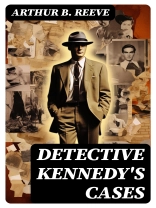In 'Detective Kennedy’s Cases’, Arthur B. Reeve masterfully weaves together a series of gripping detective stories that capture the essence of early 20th-century crime fiction. Using a blend of sharp dialogue, vivid characterization, and intricate plotting, Reeve invites readers into the world of the brilliant young detective, Kennedy. The collection reflects the literary evolution of the detective genre, drawing on elements from classic works while innovatively incorporating scientific insights and forensic techniques, a hallmark of Reeve’s narrative style. Each case unveils not only the psychological depths of the criminals but also the social contexts that shape their motivations, making it a fascinating glimpse into the era’s moral complexities. Arthur B. Reeve, a pioneer of detective fiction and a contemporary of the likes of Arthur Conan Doyle, infused his writing with his background in engineering and chemistry. His interest in scientific advancements and their implications for crime-solving is evident throughout this collection, as his tales illuminate the burgeoning field of forensic science during the early 1900s. Reeve’s work not only entertains but also reflects his passion for blending science with literature, making him a significant figure in the genre’s development. For those who are captivated by the intricacies of crime and the analytical prowess of a detective, 'Detective Kennedy’s Cases’ stands as an essential read. Reeve’s ability to intertwine scientific inquiry with thrilling narrative makes this collection an engaging exploration of mystery that will satisfy both enthusiasts of the genre and newcomers alike. Delve into these cases to experience firsthand the evolution of detective storytelling.
O autorze
Arthur Benjamin Reeve (1880–1936) was an American author best known for his creation of Craig Kennedy, sometimes referred to as 'The American Sherlock Holmes.’ Reeve’s work in the genre of detective fiction was pioneering, contributing significantly to the development of scientific detective stories at a time when public fascination with science and technology was surging. 'Detective Kennedy’s Cases’ is a testament to Reeve’s integration of early forensic science into the fabric of crime literature, leading his protagonist through mysteries solved with the aid of groundbreaking methods such as ballistics, fingerprinting, and psychoanalysis, which were emerging fields at the time. Reeve’s narrative style often combined the rationalism of deductive reasoning with the appeal of suspense and action, capturing the imagination of an audience eager for intellectual heroes. A prolific writer, Reeve produced not only a substantial series of Craig Kennedy books and stories but also wrote on a variety of other themes and was published extensively in magazines such as Cosmopolitan and Boys’ Life. His work provided a bridge between the romantic detective narratives of the 19th century and the more hard-boiled stories of the early 20th, paving the way for later writers in the genre.












